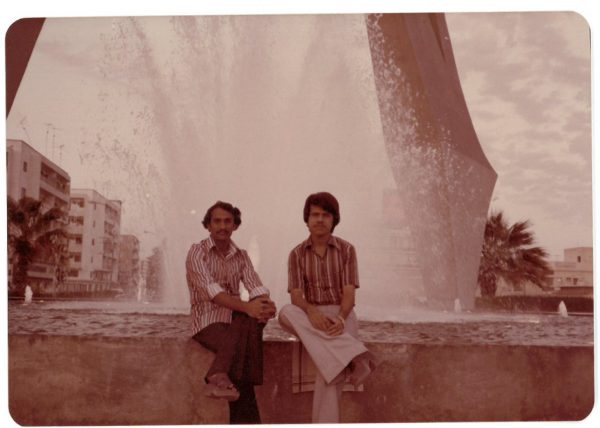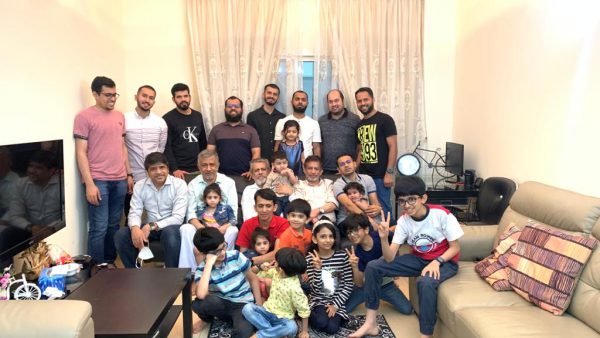Bhatkally Expat of 44 years recalls Dubai’s journey from creek town to cosmopolitan city.
02:10PM Thu 23 Sep, 2021

- Dubai was a drastically different city four decades ago — and Amjad Shahbandari has seen it all.
 After working a few odd jobs, Amjad got a job as an accountant at Fugro Middle East in 1978 and later served as the public relations officer for the company. Having worked at the same company for 43 years, Amjad is now saying goodbye.
“Leaving a place like Dubai is a grief that cannot be expressed in words,” he said. “It can just be felt and I am quite sure many have experienced this grief.”
Remembering the good old days
People who lived in Dubai decades ago never could have imagined what the city is now, Amjad said.
“It is something only the Ruler of Dubai Sheikh Mohammed could have visualised,” he said. “Back then, none of us had the slightest of idea that from just a creek town, the city would have towers ascending and tearing through the clouds.”
The lifeline of the city back then was the abra — the main public transport available at the time.
“The taxis were very cheap and people were dependent mostly on abra rides to cross the creek,” he said.
Amjad had a few relatives in Abu Dhabi, and travelled by taxi once a month to visit them.
After working a few odd jobs, Amjad got a job as an accountant at Fugro Middle East in 1978 and later served as the public relations officer for the company. Having worked at the same company for 43 years, Amjad is now saying goodbye.
“Leaving a place like Dubai is a grief that cannot be expressed in words,” he said. “It can just be felt and I am quite sure many have experienced this grief.”
Remembering the good old days
People who lived in Dubai decades ago never could have imagined what the city is now, Amjad said.
“It is something only the Ruler of Dubai Sheikh Mohammed could have visualised,” he said. “Back then, none of us had the slightest of idea that from just a creek town, the city would have towers ascending and tearing through the clouds.”
The lifeline of the city back then was the abra — the main public transport available at the time.
“The taxis were very cheap and people were dependent mostly on abra rides to cross the creek,” he said.
Amjad had a few relatives in Abu Dhabi, and travelled by taxi once a month to visit them.
 “People shared taxis in the 1980s to go to Abu Dhabi and it was just Dh5 for a one-way travel. The journey to the Capital felt long and tiring. But after the massive world-class infrastructure developed in the country, travelling to Abu Dhabi is just a cake walk,” he said.
Amjad, who received his driving license in 1984, said the process was stressful, but having a license was a matter of prestige.
“It took about eight months to get my driving license, as we got the assessment dates once every three to six months,” he said.
Moreover, there were no driving schools and those who wanted to learn how to drive had to take private classes.
Amjad also highlighted his love for Sheikh Rashid bin Mohammed Al Maktoum, who was instrumental in laying the foundation of the city.
“He was a gift from the almighty, for the poor and needy,” he said. “Sheikh Rashid introduced a health card that facilitated free health care in Dubai, which included medicines as well. This shows his love for people.”
Expecting the unexpected
In the 80s, Amjad said he and other Dubai residents thought the housing and commercial rent may decline in the coming years, but it never happened.
“We always thought the rent will decrease, but it never did. The development was lightning fast and the thought that rents might decrease vanished,” he said.
The landscape of Dubai changed every decade, he added.
“Dubai is different every 10 years. Before, it was just the World Trade Centre that was visible from afar, and now it’s hundreds of buildings,” he said.
At the time, there were only two malls.
“Wafi Mall and Al Ghurair were the two favourite places of residents and if you see now, there are countless malls,” he said.
A city for sports and art
Expats from India, Bangladesh and Pakistan frequented cricket matches at the Sharjah Cricket Stadium. Amjad still remembers the semi-final match between India and Pakistan during Rothmans Four-Nations Cup at the venue.
“March 22, 1985 was one of the most exciting days. We had been to the match and the Kapil Dev-led team was all out for 125,” he said.
After watching the first innings, he and his friends returned home disheartened with no intention of watching the second half.
“It was a Friday and it was our rest day. When we had been out in the evening, everyone was in a jovial mood as the Imran Khan-led side was all wicket down at 87 runs,” he said. “Witnessing such important events in this country cannot be forgotten.”
In addition to sports, Amjad said he has seen many cultural events, including performances by Indian poets Kaifi Azmi and Anjum Rehbar.
An ardent reader of Khaleej Times, Amjad added that he has proudly preserved the first edition of the paper.
“Khaleej Times is a gift to the UAE. It was the first English paper and expats depend on it for authentic and clear news,” he said.
He has also collected currencies of almost every nation as well as a few thousand telephone cards, 600 of which are Etisalat cards. “I have a few albums with currencies of every nation. It was a hobby and then developed into a passion.”
Amjad, who has three sons and a daughter, is flying to Mangalore, but plans to visit his second home regularly.
(Source: Khaleej Times)
“People shared taxis in the 1980s to go to Abu Dhabi and it was just Dh5 for a one-way travel. The journey to the Capital felt long and tiring. But after the massive world-class infrastructure developed in the country, travelling to Abu Dhabi is just a cake walk,” he said.
Amjad, who received his driving license in 1984, said the process was stressful, but having a license was a matter of prestige.
“It took about eight months to get my driving license, as we got the assessment dates once every three to six months,” he said.
Moreover, there were no driving schools and those who wanted to learn how to drive had to take private classes.
Amjad also highlighted his love for Sheikh Rashid bin Mohammed Al Maktoum, who was instrumental in laying the foundation of the city.
“He was a gift from the almighty, for the poor and needy,” he said. “Sheikh Rashid introduced a health card that facilitated free health care in Dubai, which included medicines as well. This shows his love for people.”
Expecting the unexpected
In the 80s, Amjad said he and other Dubai residents thought the housing and commercial rent may decline in the coming years, but it never happened.
“We always thought the rent will decrease, but it never did. The development was lightning fast and the thought that rents might decrease vanished,” he said.
The landscape of Dubai changed every decade, he added.
“Dubai is different every 10 years. Before, it was just the World Trade Centre that was visible from afar, and now it’s hundreds of buildings,” he said.
At the time, there were only two malls.
“Wafi Mall and Al Ghurair were the two favourite places of residents and if you see now, there are countless malls,” he said.
A city for sports and art
Expats from India, Bangladesh and Pakistan frequented cricket matches at the Sharjah Cricket Stadium. Amjad still remembers the semi-final match between India and Pakistan during Rothmans Four-Nations Cup at the venue.
“March 22, 1985 was one of the most exciting days. We had been to the match and the Kapil Dev-led team was all out for 125,” he said.
After watching the first innings, he and his friends returned home disheartened with no intention of watching the second half.
“It was a Friday and it was our rest day. When we had been out in the evening, everyone was in a jovial mood as the Imran Khan-led side was all wicket down at 87 runs,” he said. “Witnessing such important events in this country cannot be forgotten.”
In addition to sports, Amjad said he has seen many cultural events, including performances by Indian poets Kaifi Azmi and Anjum Rehbar.
An ardent reader of Khaleej Times, Amjad added that he has proudly preserved the first edition of the paper.
“Khaleej Times is a gift to the UAE. It was the first English paper and expats depend on it for authentic and clear news,” he said.
He has also collected currencies of almost every nation as well as a few thousand telephone cards, 600 of which are Etisalat cards. “I have a few albums with currencies of every nation. It was a hobby and then developed into a passion.”
Amjad, who has three sons and a daughter, is flying to Mangalore, but plans to visit his second home regularly.
(Source: Khaleej Times)










